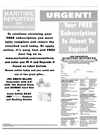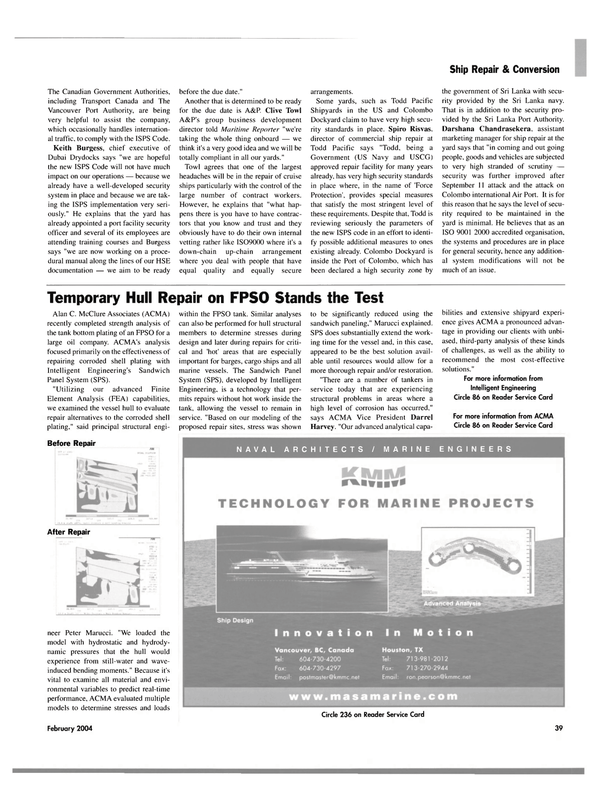
Aluminum Boats Prove Their Mettle
Aluminum Popularity Growing Fast Among Diverse Group of Boat Builders Aluminum has been used in the marine industry for more than 100 years because of its light weight and ease of fabrication combined with good corrosion and fatigue resistance. However, for much of the past 30 years, fiberglass has been the material of choice of North American boatbuilders. particularly for higher-volume production lines.
Competitively priced compared with boats made from most other materials, fiberglass boats can also be made from standardized molds that reduce their construction time and labor.
Aluminum alloys, which are specified for marine use, offer many benefits, though, too. Their high level of performance along with recent advances in aluminum cutting and welding is helping to reduce fiberglass' boats cost advantage, and the metal's utility for a wide range of boatbuilding applications is poised for reappraisal.
Changing Image of Aluminum Boats "Aluminum boat technology is relatively new." says Steve Daigle. president of Daigle Welding & Marine Ltd..
in Campbell River. British Columbia, noting that welded aluminum boats first came on the market en masse as recently as the late 1960s. Prior to that, riveting was the standard technique for joining aluminum sheets on boat hulls-a technique still used for many smaller boats that use thinner-gauge aluminum.
The image of a leaky, riveted runabout with ungainly lines persists for some people when picturing an aluminum boat. In fact, since the dawn of the welding age for aluminum boats, they have grown in stature to the point where they are the top choice in a number of categories of boats, including small recreational craft, small to medium-sized commercial fishing boats in the northwestern U.S.. crew boats in the Gulf ot Mexico, and fine yachts-both sail and motorized. Daigle himself notes that in just his 16 years in the boat business, the number of welded aluminum boat manufacturers in British Columbia has jumped from 6 to 24. But whether aluminum can make inroads into the large market for mid-sized recreational boats remains to be seen.
Corrosion-Resistant Alloys Central to aluminum's suitability for use in boat construction is the high resistance to corrosion of its alloys for marine applications when used in the specified corrosion resistant tempers.
The traditional marine alloys-5083, 5086. and 5456 as well as the more recently developed 5383 and 5059-resist corrosion in fresh water and saltwater.
A new specification ASTM B 928 "High Magnesium Aluminum-Alloy Sheet and Plate for Marine Service" has been developed to help in the selection of the appropriate alloy-temper products.
Except tor cosmetic reasons. 5xxxseries alloys don't even have to be painted above the waterline: the unpainted metal reacts with air (as would any other aluminum alloy) to form aluminum oxide-a hard, protective coating that protects the underlying aluminum. For most conditions the bottom of an aluminum hull needs only compatible antifouling paint to prevent the growth of performance-robbing barnacles and weeds and zinc anodes to prevent galvanic corrosion associated with non-aluminum metallic propulsion equipment and other attachments. Contrary to a common myth, with careful preparation and the application of proper primers and undercoats, aluminum holds paint very well. Aluminum alloys used for hull construction-commonly 5086 and 5083-are also easy to weld. Hull plating of 3/16 of an inch and above easily accommodates MIG (metal inert gas) welding for much of the basic construction.
with TIG (tungsten inert gas) welding appropriate for the more detailed work, such as attachments. What's more, advancements in welding equipment have also made this less of a chore than it used to be by using less heat, thus dis- torting the metal less when it is being joined. This results in welds that can be made more easily and more precisely.
"We've replaced all our welding equipment and now use nothing but Pulse MIGs," says Jack Winninghoff, president and owner of Winninghoff Boats, Inc., in Rowley. Mass. Pulse MIGs, which use a computer to create a controllable square wave pulse, are capable of providing smoother welds with greater penetration into the metal for a more pleasing appearance. Winninghoff describes the Pulse MIGs of the past four to five years as "a heckuva lot better- the welder has better control and can work faster," cutting an estimated 15 percent of the labor time.
Unlike fiberglass, which cannot be welded, aluminum is quick and relatively easy to weld under most conditions.
Highly shapeable, the metal lends itself to sculptured detailing with soft shapes and edges-allowing for the more attractive lines of today's aluminum craft.
More easily machined than steel, aluminum can even be cut with common carpentry tools-a router and saber, circular, and band saws-rather than a torch.
In addition, hull fittings such as bait tank pumps and depth finders can be installed by simply drilling and tapping into the hull with a stainless steel fastener.
flere again, however, computers are starting to revolutionize this aspect of the aluminum boatbuilding business, with cost-saving results. Both custom and production boatbuilders can now create hull designs with three-dimensional CAD (computer-aided design) software that can be fed directly to a computer-controlled cutting table, making for uniform, more quickly cut, pieces. Ease of cutting and welding is a factor not only during the construction process, but also for repairs and remodeling.
Since aluminum boats are not built from molds, changes in design, altering the location of bulkheads, resizing cabins, etc., are all accomplished more easily than on fiberglass boats.
Equipment can also be relocated more easily on an aluminum boat-by cutting and welding or drilling and bolting-than on fiberglass. As for durability and reparability: aluminum comes out ahead of both steel and fiberglass. Compared with a steel hull, a "strength-equivalent" aluminum hull (i.e.. built to the same stiffness) boasts about 29 percent greater dent resistance and 12.5 percent greater resistance to rupture, according to Michael Kasten. of Kasten Marine Design, Inc., of Port Townsend, Wash.
With regard to flammability, aluminum does not burn and requires a temperature of over 1,000° F to melt.
Further, aluminum boats can be easily fitted to provide "structural fire protection." i.e.. containment of fire in a particular compartment by the craft's structure without help from firefighting systems.
Lightness + Strength = Versatility An aluminum boat of a strength equal to a comparably designed steel or fiberglass boat will weigh less by approximately 20 percent or more. In fact, weight savings of 35c/c to 45r^ in hulls, and 55'/c to 65f/r in superstructures, can be achieved with aluminum compared to steel. Put another way, pound for pound aluminum is stronger than either material.
Aluminum's weight advantage means that an aluminum craft of comparable design and equal strength will generally move more quickly if sail driven, use less fuel if motor-driven, be able to accommodate a heavier cargo, and be more easily trailerable than its steel and fiberglass counterparts. Higher vessel speeds and load capacities, enabled by use of aluminum, attract extra traffic volume and profit for the ferry operator.
The use of aluminum can also improve seaworthiness, safety, and reliability, and lower maintenance costs.
For information on aluminum products for the marine market visit: Alcan Inc.
http://www.rolleclproducts.alccin.com/index.html ?menuID=2&segmentID=10&action=segment Alcoa Inc.
http://www.alcoa.com/global/en/ahout_alcoa/hu sinesses/alcoa_mill._prod.asp Corns Aluminium Rolled Products http://www.corusgroupkohlenz.
com/english/products/shiphuilding/inde x.htm Kaiser Aluminum <6 Chemical Corp.
http://www.kaiseral.com/kaiser/kaisermain.nsf Pechiney Rolled Products http://www.sheet-coil.pechiney.com/isbin/ lNTERSHOP.enfinity/eTS/Store/-/-/- /Marine_Storefront-Start?Activite=Marine Many aluminum products for marine applications are also available through the distribution network. The Metal Serx ice Center Institute web site (http://www.msci.org/sitemap.adp ) can help find a distributor
Read Aluminum Boats Prove Their Mettle in Pdf, Flash or Html5 edition of February 2004 Maritime Reporter
Other stories from February 2004 issue
Content
- Northrop Grumman Delivers Aegis Destroyer page: 3
- Izar Gijon Delivers Two Massive Dredgers page: 10
- Boeing Connexion Moves to the High Seas page: 10
- New Ferries for Hawaii? page: 11
- Damen Delivers First-of-Class ASD Tug page: 12
- OMI Pleads Guilty to Illegal Dump, To Pay $4.2M Fine page: 14
- Teekay Orders Aframax Tankers page: 15
- Wartsila to Discontinue Production in Turku page: 15
- China Preps To Take World Lead page: 16
- Secondhand Prices Tanker Prices Up 35% page: 16
- Continuous Synopsis Record page: 18
- A 3D Virtual Interface to Access Ship Data page: 20
- MAN B&W Debuts ME-GI Dual Fuel Engine page: 21
- Rebuilding Single Hull Tankers to Double Hull Tankers page: 22
- Thor-Lube Stern Tube Bearing System on Shell LNG Carrier page: 24
- K-Sea Acquires Integrated Tug Barge Unit page: 25
- Boosting Deepsea RoRo Capacity page: 25
- MTS Rosette: State of the Art Inland Tank Ship page: 26
- Fourth New ATB Tank Vessel for MTC page: 30
- Company Focus: Staying Connected with INTERCON page: 31
- Innovative Coastal Trader page: 32
- Halifax Shipyard On Hand To Replace Lost Rudder page: 33
- East Isle Shipyard Wins $16M Contract page: 34
- Transport Canada Takes Lead on Safety page: 35
- Hike Metal: Steady Progress to Success page: 36
- Car Ferry Saves Fuel with New Engines page: 37
- The ISPS Code page: 38
- Temporary Hull Repair on FPSO Stands the Test page: 39
- New 12,000-sq.-m. Workshop Pays Dividends page: 41
- Series Design in the New Regs Environment page: 42
- Aluminum Boats Prove Their Mettle page: 44
- Success Aboard QM2 page: 49
- LCD's Turning Black page: 50
- The Needs of Maritime Electronic Equipment page: 51
- Advantage of Marine Guard Foam Filled Marine Fenders page: 52


